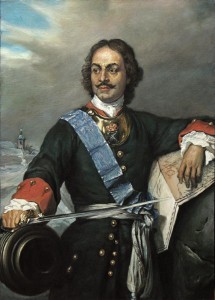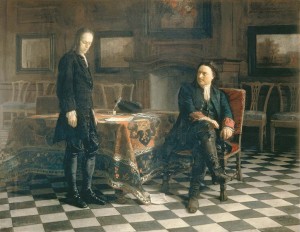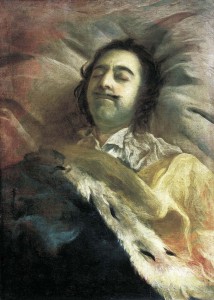| Peter the Great | |
|---|---|
 |
|
| Tsar of Russia | |
| In Power | 1682-1725 |
| Born | June 9, 1672 Moscow |
| Died | 1725 Saint Petersburg |
| Nationality | Russian |
| Royal House | The House of Romanov |
Peter the Great (1672 – 1725) began as the Tsar of Russia and eventually became the Emperor. He was the grandson of Tsar Michael Romanov and was made Tsar when he was only ten years old. His early life was incredibly privileged and he was educated by several notable intellectuals. In adulthood, Peter I was known for being very tall. Some historians believe he may have suffered from a form of epilepsy.
Tsar Alexis I, Peter’s father, died in January of 1676. Following this, his brother Feodor III became ruler. However, Feodor was chronically ill and died after less than ten years on the throne. Since Feodor had no children, a dispute arose about who should inherit the throne.
Ivan I was Peter’s older half-brother and next in line. However, as he was considered chronically ill and mentally unfit, he was passed over in the succession. Ivan’s side of the family was defeated by Peter’s, who was taken to the Kremlin to be established as Tsar. However, Ivan’s family managed to orchestrate a coup d’état. Many of Peter’s friends and family were murdered during this conflict.
A New Tsar
Ivan and Peter were proclaimed joint Tsars at the Miloslavskys’, Ivan’s family, insistence. Sophia Alekseyevna, Peter’s relative, who had orchestrated the rebellion in the first place, assumed power as the acting regent. She acted as regent for several years and advised Ivan and Peter in all matters when necessary.
Peter did not have much interest in ruling when he was young. In an attempt to foster his interest, he was sent away to Kolomenskoe where he learned military strategy. He became friends with some European soldiers who taught him Western military strategies. He also studied shipbuilding and became interested in developing a navy for Russia.
Peter was nearly eighteen when he returned to Moscow, and he intended to take power back from Sophia. She knew about this and tried to stage another coup d’état, but Peter managed to defeat her. Sophia was sent to a convent and had to give up her name and standing as a member of the royal family.
Peter Becomes Sole Ruler
Although Sophia’s rule was overthrown, Peter remained Tsar alongside Ivan V. However, his mother ruled as regent until she died in 1694. Ivan V remained Tsar for the rest of his life, dying six years later, making Peter the sole ruler of Russia.
Peter decided to travel around Western Europe and learn as much as possible about its culture. After his return, he westernized Russian technology and military tactics. His time abroad was spent trying his hand at different professions based on a strong belief in ‘meritocracy’. He worked many occupations, including dentistry.
The Westernization of Russia
Peter’s obsession with west was not constrained to matters like the organization of the military. He started to tax men that had beards and forced the people to wear western style clothes. He changed the calendar, opened technical schools, and banned the traditional Muscovite dress for all men. He introduced a variety of other reforms that radically changed the life of the people, many of which were widely disliked.
Peter’s reaction to these detractors was a swift and painful. He suppressed all forms of rebellion. All armed forces and state officials were made to wear modern clothes and shave their beards to speed along the modernization of Russia as Tsar Peter saw fit.
He believed in the concept of education and disliked hereditary positions, which he abolished during his reign. He made changes to the church and instated a council to govern it. He also greatly increased the amount of education that the people received, building the first universities in Russia. He endeavored to stop arranged marriages, something which affected him personally as his own arranged marriage was disastrous. Eventually, he sent his wife to a convent in order to free himself of matrimony.
St. Petersburg and the Emperor
Peter the Great decided to move the capital of Russia from Moscow to St. Petersburg. This was a massive project that required a city to be built on the Gulf of Finland. It took nearly a decade to complete and tens of thousands of people died during its production. St Petersburg remained the capital of Russia until the communist revolution in the year 1918.
Opposition in the Family
 Both the clergy and the nobility disagreed with many of his reforms and there were many rebellions that Peter successfully suppressed. The nobility were, in large part, Peter’s family, and many of them were opposed to the changes he was making.
Both the clergy and the nobility disagreed with many of his reforms and there were many rebellions that Peter successfully suppressed. The nobility were, in large part, Peter’s family, and many of them were opposed to the changes he was making.
Peter the Great had 14 children, 3 or which survived to adulthood. Alexei was the eldest surviving child. However, Peter learned that he had been involved with plots to overthrow his reign and had him arrested. Alexei was interrogated and tortured for days before he confessed to treason. He was sentenced to death, yet he died in prison due to injuries sustained while being tortured.
Because of this, Peter the Great decided that the next ruler should not be determined by means of heredity. He instated reforms which disbanded hereditary claims to any position, angering many of the nobles.
The Death of Peter the Great
 In his old age, Peter began to suffer from bladder and urinary tract problems. Doctors performed surgery and relieved around four pounds of urine from his bladder. Though he recovered for a time, the problems returned worse than before. He died on February 8, 1725 without naming an heir. An autopsy preformed after his death revealed that his bladder had been infected with gangrene.
In his old age, Peter began to suffer from bladder and urinary tract problems. Doctors performed surgery and relieved around four pounds of urine from his bladder. Though he recovered for a time, the problems returned worse than before. He died on February 8, 1725 without naming an heir. An autopsy preformed after his death revealed that his bladder had been infected with gangrene.
Legacy
Peter the Great was a very controversial figure that managed to expand Russia, westernize its culture, and establish it as a major European power. Under Tsar Peter’s rule, Russia became an empire.